Health and Safety
Guided by our Health and Safety Principles, we carry out daily health and safety activities
as part of our commitment to preserving the health and safety of workers and providing a comfortable work environment.
Health and Safety Principles
Ensure the safety and health of all workers at construction sites and create comfortable workplace environments
The Obayashi Basic Principles state "value each person with a stake in our business". We therefore make the safety of our construction sites, where so many people work, a top priority. We also practice health and safety day to day under our Health and Safety Policies.
Health and Safety Policies
- 1 Comply with the Industrial Safety and Health Act, other relevant laws, and Obayashi Corporation's internal rules
- 2 Appropriately implement and use Obayashi's Occupational Health and Safety Management System
- 3 Help improve the independent health and safety management efforts of suppliers
Occupational Health and Safety Management System
We have established a Central Health and Safety Committee chaired by the president. It meets at least twice a year to discuss and consider the basic matters concerning occupational accident prevention and health maintenance and promotion.
We also operate the Occupational Health and Safety Management System, which brings all our safety management methods together, to put the Health and Safety Principles into action.
This system clarifies the occupational health and safety policy of the organization. It allows us to manage structures, plan formulation and procedures for the cycle from implementation to achievement, review and maintenance. We aim for continual improvement by setting policies and targets and following the PDCA cycle.
Furthermore, we have health and safety management systems in place so we can respond rapidly in case an occupational accident, natural disaster, or other emergency actually happens.
-
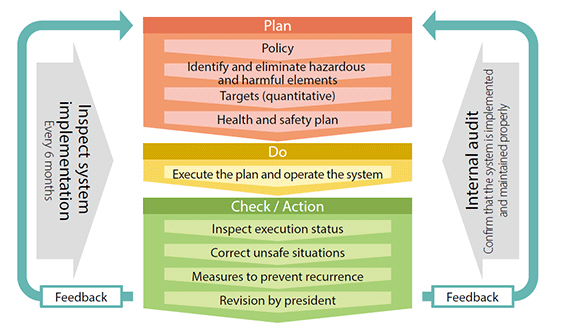
Occupational Health and Safety Management System
-
Health and Safety Management Framework
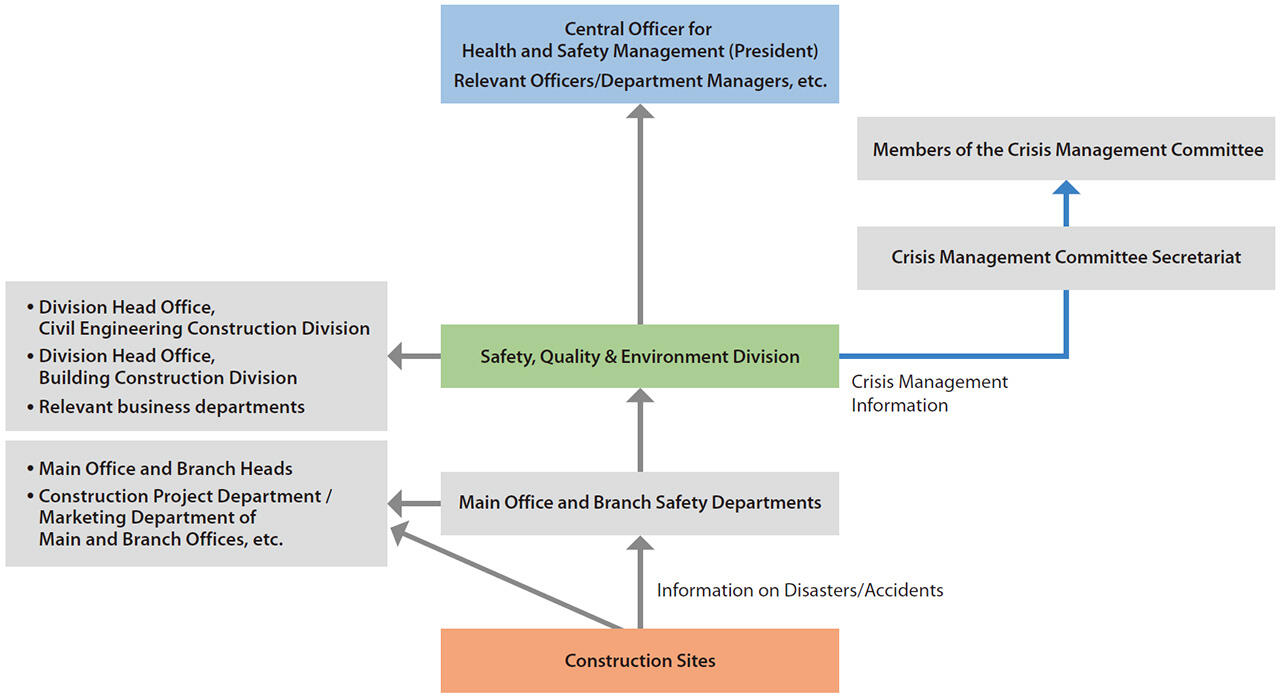
Initiatives for the Prevention of Workplace Accidents
Targets and Priority Measures for FY 2022.3
Target
Eliminate fatal accidents and serious accidents
Priority Measures
- 1 Prevent occupational accidents under the strong leadership of the project director
- 2 Plan and execute appropriate work procedures and confirm them onsite
- The project director should check and approve the work plans, which are prepared together with suppliers according to the characteristics of the site and the work content
- Inform all the workers of the work plans and procedures before work
- Follow the work procedures, and confirm on-site that work is being carried out as planned
- If work is changed, the work should be temporarily stopped, and it should be resumed only after re-planning and re-informing
- There continue to be many repeat accidents. Therefore, when preparing work plans and work procedures, investigate past accident examples and then adopt plans and procedures that fully reflect the causes of those accidents and measures against them
- 3 Prevent accidents resulting in falls
- Complete installation of safety equipment such as fall prevention equipment
- Must use safety belts
- Prevent falls from low places
- 4 Prevent machinery accidents
- Prevent accidents caused by construction machinery, especially backhoes
- Prevent accidents due to sling work
- Prevent accidents due to use of tools
- 5 Prevent landslide accidents
- Prepare a concrete work plan upon grasping the soil properties under the construction conditions (e.g., moisture content, vibrations and load).
- Appoint an Operations Chief of Excavating Natural Ground and then make sure to inspect the natural ground before work. If it is different from what was assumed at the time of the initial plan or if an abnormality is found in the inspection, make sure to temporarily stop work.
- Draft and execute measures after fully understanding the level of the risk of a landslide even in small-scale gutter excavation work.
- 6 Prevent fire accidents
- Remove and cover surrounding combustibles in work using fire, such as welding and fusing
- Thorough fire prevention caused by plastic insulation materials such as urethane foam (Work involving the use of fire should be finished before performing work to spray urethane and other substances)
- Thorough assignment of inspectors during work using fire
- 7 Prevent damage to third parties due to accidents
- Prevent materials falling outside the site
- Prevent falls near the entrances and exits of the construction sites, and collisions with construction vehicles
- Prevent traffic accidents during commuting
- 8 Increase health and safety management capabilities and strengthen training
- Strengthen training for employees and workers
- Establish and guide voluntary safety and health management activities by suppliers
- 9 Promote creation of healthy work environment
- Place proper workers in consideration of their health and age
- Implement measures to prevent heatstroke and response promptly to suspected heatstroke
- Promotion of the mental and physical health of employees
Three Major Initiatives
To prevent faults in safety equipment and unsafe behavior on construction sites, we are rigorously implementing the following measures.
Initiative for Enhancing On-Site Inspections : Most important initiatives for FY2021.3
Our employees and supplier supervisors check directly on the implementation of safety measures at worksites to avoid unsafe action. Any faults are corrected on the spot.
Initiative to Encourage Calling
Under our construction site rules, workers who see someone doing something unsafe are required to verbally caution them. We strive to make an environment where people can call out each other freely.
ATKY Initiative
Our employees and others working on construction sites actively employ pointing and calling to ensure safety, inspection, and check (in Japanese, anzen, tenken, kakunin or "ATK") and hazard prediction(kiken yochi or "KY"). This method enables them to identify hazards and harmful factors before starting an operation and take proper countermeasures.
Sharing Information on Health and Safety and Preventing Recurrence
When a serious accident occurs, we work to prevent recurrence by compiling information on the circumstances, causes, and measures to prevent recurrence. We also share this information with all our employees on the Intranet and through other means, and conduct the necessary training at construction sites. We also establish a committee if we consider there are high risks in the nature of the work. For example, a committee for managing work conditions inside tunnels specifies health and safety risks and discusses ways to improve.
Safety Patrols
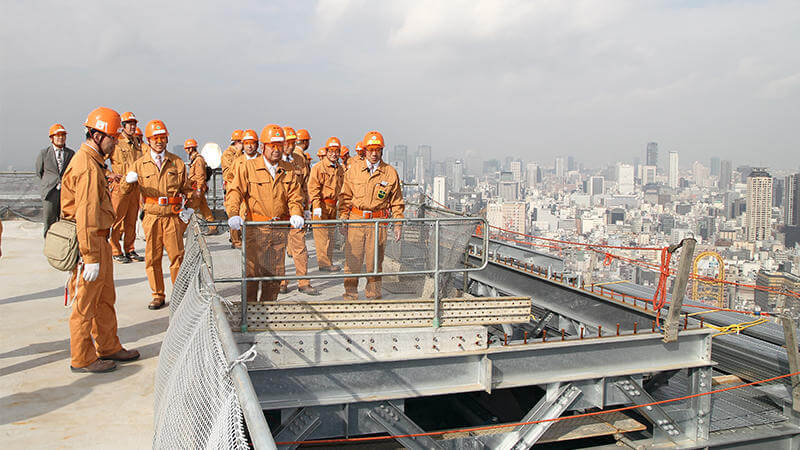
All branches conduct patrols to confirm health and safety management conditions at construction sites. Especially for sites with many workers or large-sale sites, safety patrols are held by Health and Safety Officers at each branch and at the main office at least once a month. We hold daily patrols conducted by employees and subcontractors at construction sites.
They check to make sure that appropriate guidance on health and safety is being provided and monitor the health and safety of subcontractors, among other things.
Additionally, the central officer in charge of health and safety and secondary officer in charge conduct special patrols two times a year. We also run patrols to verify dust hazard prevention efforts at tunnel construction sites and so forth.
Furthermore, the Safety and Quality Supervisor under the direct supervision of the Safety, Quality & Environment Division patrols construction sites around Japan, giving meticulous instruction and training.
Check lists are always used on patrols to determine whether identified issues were ultimately corrected.
Safety Trainings
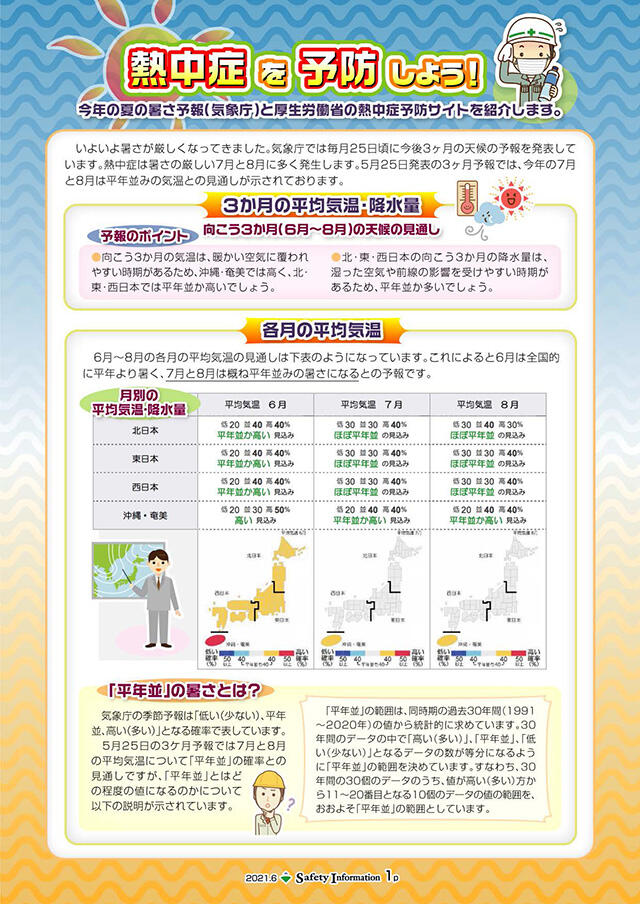
We provide training for employees and support education of suppliers to prevent occupational accidents, improve awareness of health and safety, and provide a deeper understanding of safety-related laws and regulations and other aspects. We provide hands-on training to employees who work at construction sites to heighten their sensitivity to the hidden dangers at construction sites. Our goal is to improve the ability to prevent accidents and instruct subcontractors for safety matters through simulation-based learning of actual accidents.
The Safety Information bulletin published every month also provides information on cases of high-risk accidents and ways to prevent them, in addition to information on revisions to various laws and regulations and our safety and accident record. For example, the bulletin addresses the prevention of high-risk incidents such as heat stroke in the summer and falls due to ice in the winter.
We also have safety materials in multiple languages for foreign technical trainees and foreign construction employees who work on construction sites. These materials explain the proper procedures when entering a site, so the foreign trainees and workers can correctly understand the safety rules. We have in addition installed safety markers and signs in appropriate languages at construction sites to help ensure safety while working.
We have established an environment in which safety information is always accessible by posting this information on the Intranet, providing regular e-learning based on actual accidents to employees, and other means. We caution employees by making sure that they see information on safety on a daily basis, promoting greater safety awareness, and working diligently to ensure safety at construction sites.
Safety Awards
We provide awards to construction sites that excel in daily safety management aimed at heightening safety awareness and improving the quality of safety management, and that serve as a model for other sites.
Safety Trainings for Suppliers
In the Obayashi Accident Prevention Association, which consists of subcontractors who work on our construction projects, Obayashi and subcontractors work as one team to improve the level of health and safety. They conduct safety patrols, provide health and safety education, and create educational DVDs for skilled construction workers, among other efforts.
Obayashi actively supports the establishment and enhancement of its management systems aimed at improving the ability of subcontractors to manage health and safety autonomously.
-
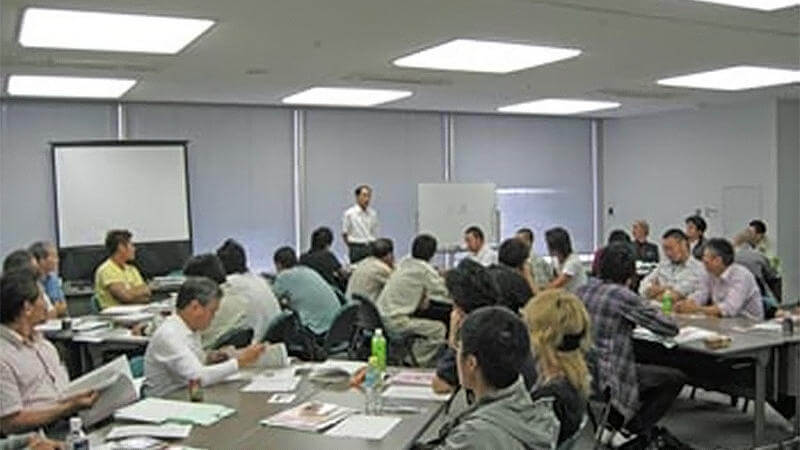
An accident prevention association holds several workshops to learn safety rules
-
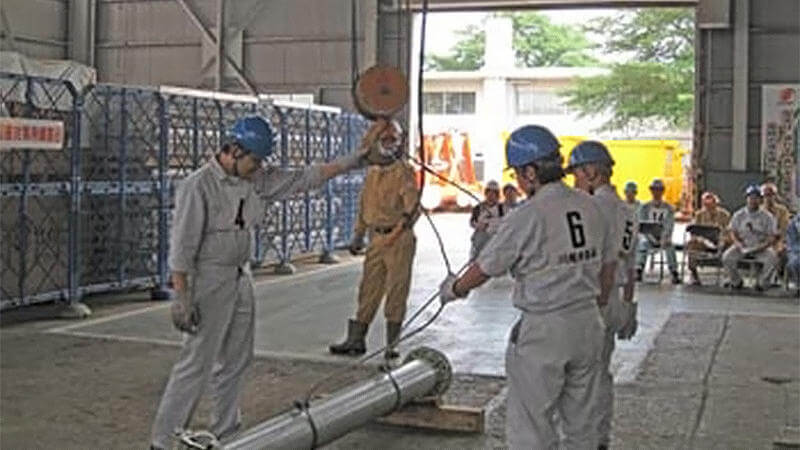
A scene from slinging training
Training DVDs
In cooperation with the Obayashi Accident Prevention Association, which consists of Obayashi suppliers and subcontractors, we produce safety training DVDs dealing with themes selected from current issues in the health and safety of construction sites. These DVDs are used in trainings given at construction sites and independently at partner companies.
-
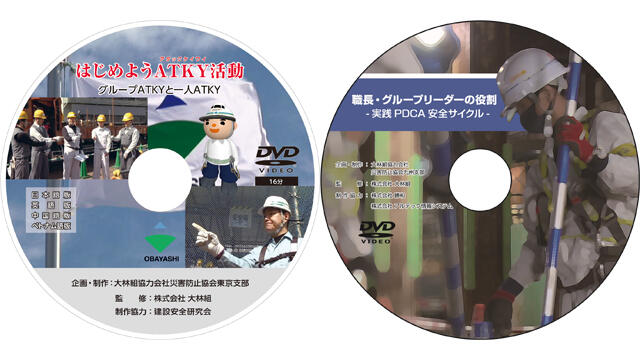
Training DVDs -
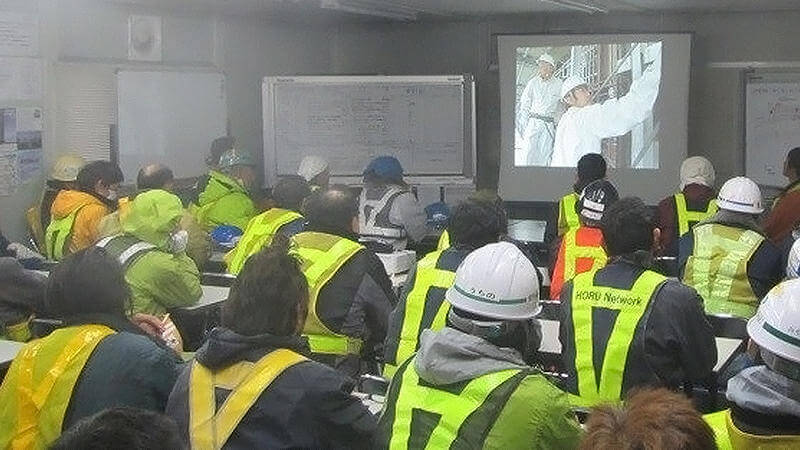
DVDs are used in training dispatch workers at construction sites
Occupational Accidents Data (Including skilled workers on construction sites)
| FY2017.3 | FY2018.3 | FY2019.3 | FY2020.3 | FY2021.3 | |
|---|---|---|---|---|---|
| Accident frequency rate(*1) | 0.47 | 0.55 | 0.58 | 0.44 | 0.32 |
| Severity rate(*2) | 0.25 | 0.11 | 0.32 | 0.10 | 0.23 |
| Accidents resulting in four or more lost workdays (cases) | 47 | 53 | 59 | 45 | 29 |
| (reference) Accident frequency rate: All industries(*3) | 1.63 | 1.66 | 1.83 | 1.80 | 1.95 |
| (reference) Accident frequency rate: Construction industry(*3) | 0.64 | 0.81 | 1.09 | 1.69 | 1.30 |
- *1 The number of work-related injuries or deaths recorded for every 1 million work hours
- *2 The number of workdays lost to workplace accidents recorded for every 1,000 work hours
- *3 Based on Industrial Accident Research by Ministry of Health, Labour, and Walfare of Japan
Striving for Workstyle That Make it Easy to Work
The ultimate goal of workstyle reform in the construction industry is to secure the workers needed by the construction industry and ensure healthy development of the construction industry. Obayashi is focusing on achieving a five-day work week (closed eight days in four weeks) as a first step toward reducing long work hours at construction sites. To achieve this for employees and skilled workers, we need to establish reasonable construction periods. Gaining the understanding of customers is essential to accomplish that. We are explaining this to customers through the pamphlet published by the Japan Federation of Construction Contractors and other means.
Please see Work-Life Balance for more information on health management and promotion.


